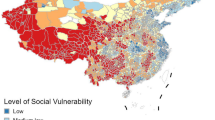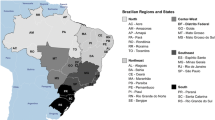Abstract
The hazards of place framework developed by Cutter (1996) has been applied to several areas across the United States. This article tests the applicability of that model for analysis of hydrological disasters in the municipio of San Juan, Puerto Rico. San Juan is chosen because it combines many socioeconomic attributes of a develo** area while offering data availability befitting its status as a US commonwealth. The interoperability of principal components and arithmetically based methods for producing a social vulnerability layer are examined. For both methods, a basket of commonly cited demographic variables representing social and economic vulnerability is extracted from Census 2000 sample (SF-3) data at the census block-group level of analysis. These results provide insight on the strengths and weaknesses of the methods both methodologically and regarding policy implementation. A look at the neighborhood of La Perla suggests complex local positive and negative effects of local processes on vulnerability not captured by demographic analysis. These effects relate to possible census undercounts in peripheral areas and uncaptured co** ability provided by social networks.
















Similar content being viewed by others
References
Arroyo, M. L. (August 18, 2005). Personal Interview.
Associated Press Report. (September 28, 2002). San Juan Herald.
Bankoff, G. (2004). The historical geography of disaster: ‘Vulnerability’ and ‘Local Knowledge’ in Western Discourse. In G. Bankoff, G. Ferks, & D. Hilhorst (Eds.), Map** vulnerability. (pp. 10–24). London, UK and Sterling, VA: Earthscan.
Boruff, B. J., Emrich, C., & Susan L. C. (2005). Erosion hazard vulnerability of US coastal counties. Journal of Climate Research, 21(5), 932–942.
Britton, N. R., & Lindsay, J. (1995). Integrating city planning and emergency preparedness: Some of the reasons why. International Journal of Mass Emergencies and Disasters, 13(1), 93–106.
Cardona, O. D. (2004). The need for rethinking the concepts of vulnerability and risk from a holistic perspective: A necessary review and criticism for effective risk management. In G. Bankoff, G. Ferks, & D. Hilhorst (Eds.), Map** vulnerability. (pp. 37–51). London, UK and Sterling, VA: Earthscan.
Chakraborty J., Tobin G. A., & Montz, B. E. (2005). Population evacuation: Assessing spatial vulnerability in geophysical risk and social vulnerability to natural hazards. Natural Hazards Review, 6(1), 23–33.
Collins T. W. (2005). Households, forests, and fire hazard vulnerability in the American West: A case study of a California community. Environmental Hazards, 6, 23–37.
Cutter S. L. (1996). Societal responses to environmental hazards. International Social Science Journal, 150, 525–536.
Cutter S. L., Boruff B. J., & Shirley, W. L. (2003). Social vulnerability to environmental hazards. Social Science Quarterly, 84(2), 242–261.
Cutter S. L., Mitchell J. T., & Scott, M. S. (2000). Revealing the vulnerability of people and places: A case study of Georgetown, Carolina. Annals of the Association of American Geographers, 90(4), 713–737.
DeGraff, J. V., Bryce, R., Jibson, R. W., Mora, S., & Rogers, C. T. (1989). Landslides: Their extent and significance in the Caribbean. In E. E. Brabb, B. L. Harrod, & A. A. Balkema (Eds.), Landslides: Extent and economic significance. (pp. 51–80). Rotterdam: A.A. Balkema.
Fraser, M., Neil, W., & Slaymaker, O. (2003). Mutual vulnerability, mutual dependence: The reflexive relation between human society and the environment. Global Environmental Change, 13(2), 173–144.
Government Development Bank for Puerto Rico. (2005). Puerto Rico in figures. Office of Analysis and Economic Studies. Commonwealth of Puerto Rico. Retrieved from http://www.gdb-pur.com/economia/prcfras/documents/PRCifras05.pdf. Accessed 27 October 2006.
Harvey, F. (1997). From geographic holism to Geographic Information System. The Professional Geographer, 49(1), 77–85.
Larsen, M., & Andrew, S. (1993). A Rainfall intensity-duration threshold for landslides in a humid-topical environment, Puerto Rico. Geografiska Annaler, 75, 1–2.
Malgrem, B., & Amos W. (1999). Climate zonation in Puerto Rico based on principal components analysis and an artificial neural network. Journal of Climate, 12, 977–985.
Morrow, B. H. (1999). Identifying and map** community vulnerability. Disasters, 23(1), 1–18.
Oficina de Plan de Uso de Terrenos de Puerto Rico, (n.d.). Retrieved from http://www.gobierno.pr/OPUT/Mapas/. Accessed 16 November 2006.
Oficina de Planificacion. (2003). Plan de Mitigación Multi-Riesgo. Retrieved from http://www.oficinadigital.com/files/docs/99210TGXU4.PDF. Accessed 12 February 2006.
Palm, R., & Michael, E. H. (1993). Natural hazards in Puerto Rico: Attitudes, experience, and behaviors and homeowners. Geographical Review, 83(3), 164.
Papathoma, M., Dominey-Howes, D., Zong, Y., & Smith, D. (2003). Assessing tsunami vulnerability, an example from Herakleio, Crete. Natural Hazards and Earth System Sciences, 3, 377–389.
Rashed, T., & Weeks, J. (2003). Assessing vulnerability to earthquake hazards through spatial multicriteria analysis of urban areas. International Journal of Geographical Information Science, 17(6), 547–576.
Schröter D., Polsky, C., & Patt, A. G. (2005). Assessing vulnerabilities to the effects of global change: An eight step approach. Mitigation and Adaptation Strategies for Global Change, 10(4), 573–596.
US Census Bureau. September (2001). Household and families. Document Reference C2KBR/01–8.
USGS, Puerto Rico Office. (1991). Elements of slope hazard evaluation: Guidelines for determining landslide risk. Guaynabo: PR.
Wood, D. (2004). Five billion years of global change. New York, London: The Guilfod Press.
Wu, S-Y., Brent, Y., & Ann, F. (2002). Vulnerability of coastal communities to sea-level rise: A Case study of Cape May County, New Jersey. Climate Research, 22, 255–270.
Zimmerer, K. S., & Thomas J. B. (2003). Approaching political ecology: Society, nature, and scale in human-environmental studies. In S. Z. Karl, & J. B. Thomas (Eds.), Political ecology: An integrative approach to geography and environment-development studies (pp. 1–25). New York: The Guilford Press.
Author information
Authors and Affiliations
Corresponding author
Rights and permissions
About this article
Cite this article
Azar, D., Rain, D. Identifying population vulnerable to hydrological hazards in San Juan, Puerto Rico. GeoJournal 69, 23–43 (2007). https://doi.org/10.1007/s10708-007-9106-8
Received:
Accepted:
Published:
Issue Date:
DOI: https://doi.org/10.1007/s10708-007-9106-8




